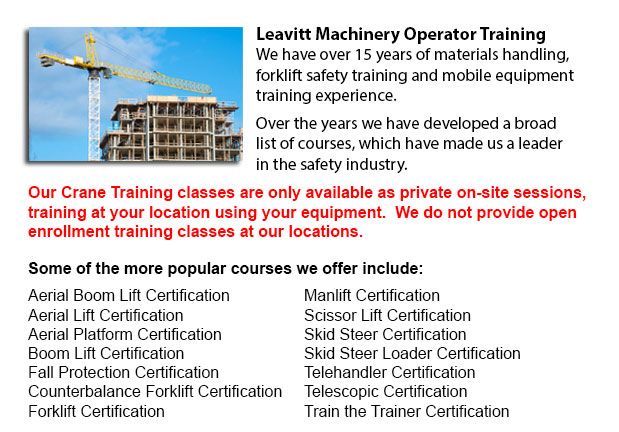
Kamloops Crane Certification - The Crane Certification Program consists of the industry recommended content which will teach the safe and efficient operation of cranes. The individual will train in the following: how to identify cranes and their component parts; pre-operational, operational and post-operating requirements; rigging components and inspection/rejection criteria; how to determine overall lift capacity; and requirements specific to the work place where the people training would be operating.
The requirements that must be carried out before operating a crane like for example assigning authority for the pre-operational check; performing the sequential pre-operational check based on the manufacturer's specifications or specifications certified by a professional engineer; checking the log book for comments; inspecting the work area for obstacles and hazards; inspecting chains, cables, hooks crane movement and safety latches; making sure of the right functioning of operational controls; and knowing how to make sure that the disconnect switch/isolator of the crane is properly functioning.
Operational requirements comprise identifying roles and responsibilities, and determining the need for a formal lift plan. Trainees would be taught how to carry out a danger assessment associated to environmental circumstances, physical conditions and employees. Subject matter consists of determining when to seek competent support, the destination of loads and the safest route, and centre of gravity and load weight.
It is very important for people training to be able to identify an over-capacity lift, pick correct rigging machinery, be aware of load restrictions, and determine a safe location from which to operate. Individuals training would review both site-specific and universal crane signals for lifts, and techniques for traveling, lifting and loading. Right maintenance practice would be covered.
Individuals training will be assessed on their understanding of the need for emergency response procedures for various scenarios such as a mechanical or electrical failure. They would be asked to describe parking and shut down procedures for safety and security, to follow lock out and tagging procedures, and to explain why near misses are recorded and reported to the appropriate person. Log book records must be maintained.
The trainee will be taught the particulars of rigging, and be taught the authority and responsibility for rigging. They would be taught to identify the various types of rigging, the load capacity ratings and storage procedures.
Post-operational requirements consist of entering defects or deficiencies, service and maintenance history in the log book, according to Federal, state and provincial codes requirements.
Site-specific needs can be incorporated into the safety training program based on the employer's needs.
-
Kamloops Counterbalance Forklift Training
Kamloops Counterbalance Forklift Training - Counterbalance Forklift Training courses are always in high demand. The Counterbalance forklift is a forklift which is made with a weight which counters the balance, equally spreading the weight of the load... More -
Kamloops Manlift Certification
Kamloops Manlift Certification - The Manlifts and Elevated Platforms program offers training on the rules, regulations and proper application of safe operating measures and work practices included in daily activities for people who work making use of... More -
Kamloops Boom Lift Training
Kamloops Boom Lift Training - Elevated work platforms, likewise referred to as aerial platforms, allow workers to carry out tasks at heights that will otherwise be not reachable. There are various styles of lifts designed for different site applicati... More -
Operator Safety Certification | Re-Qualification Certification | In-House Instructor Certification in Kamloops
Forklifts are used in just about all industrial construction sites and in warehouse operations and in boat yards. The reach feature of a lift truck is a vital component used in several applications like for instance when a shelving system is being us... More -
Kamloops Manlift Safety Training
Kamloops Manlift Safety Training - It is essential for competent Manlift operators to be aware of the connected dangers that come with particular kinds of scissor lifts. They must be able to operate the scissor lift in a way that protects not only th... More -
Kamloops Crane Training Schools
Kamloops Crane Training Schools - We have designed several programs for Mobile Crane Operation at our Crane Training Schools. These programs are recommended for the experienced operator who requires certification or re-certification, and for inexperi... More -
Skid Steer Loader Certification in Kamloops
The engine powered skid-steer loader consists of a rigid and small frame, outfitted together with lift arms which could attach to a lot of industrial attachments and tools to perform several labor saving jobs. Typically, skid-steer loaders are four-w... More -
Kamloops Heavy Equipment License
Kamloops Heavy Equipment License - A heavy equipment license could be acquired by taking a certification and preparation course at a private training school or a vocational school. This license would qualify you to operate various types of heavy mach... More

Forklift Certification Kamloops
TOLL FREE: 1-888-254-6157
Kamloops, British Columbia
forkliftcertificationkamloops.com/
Email Us
About Us


